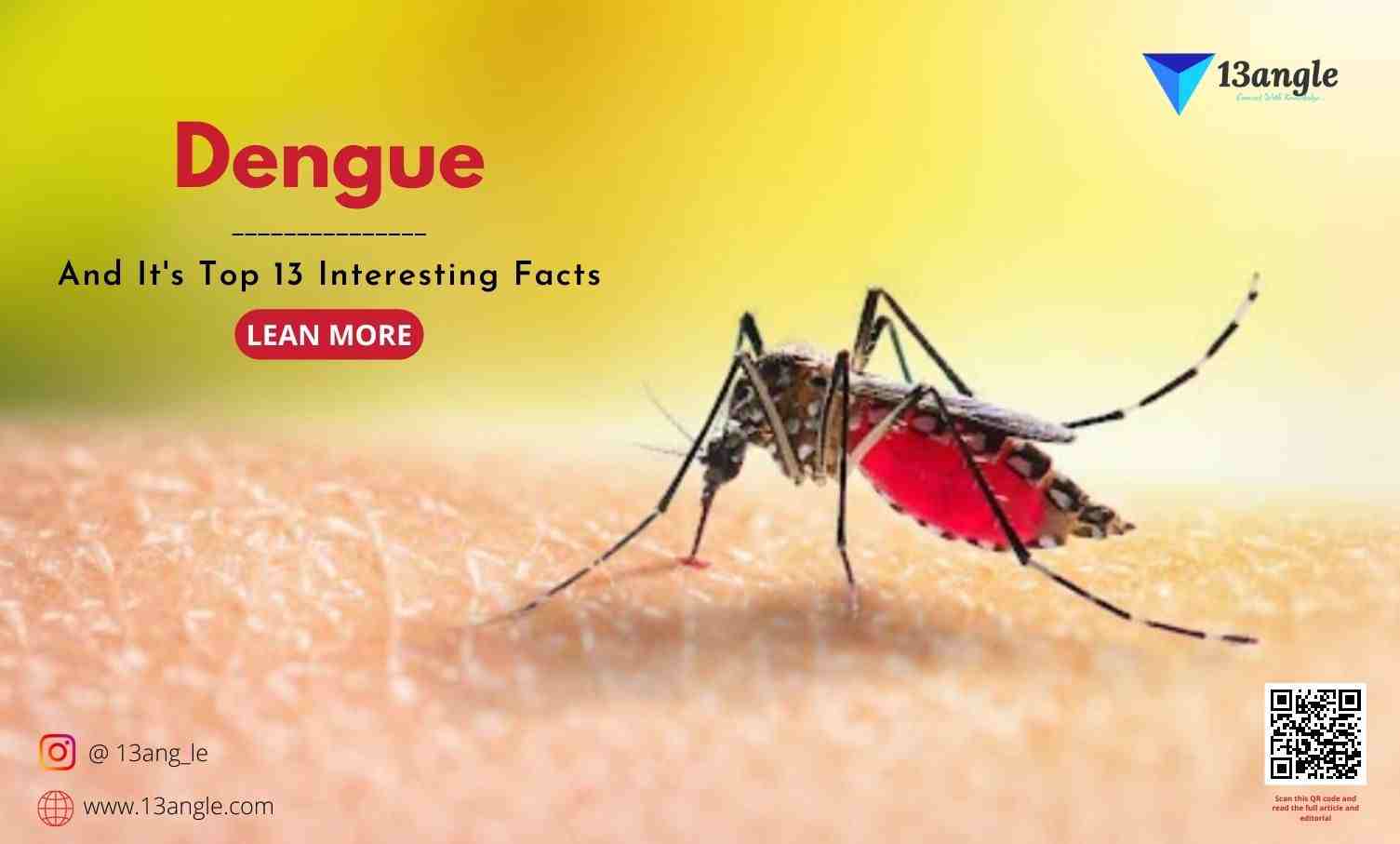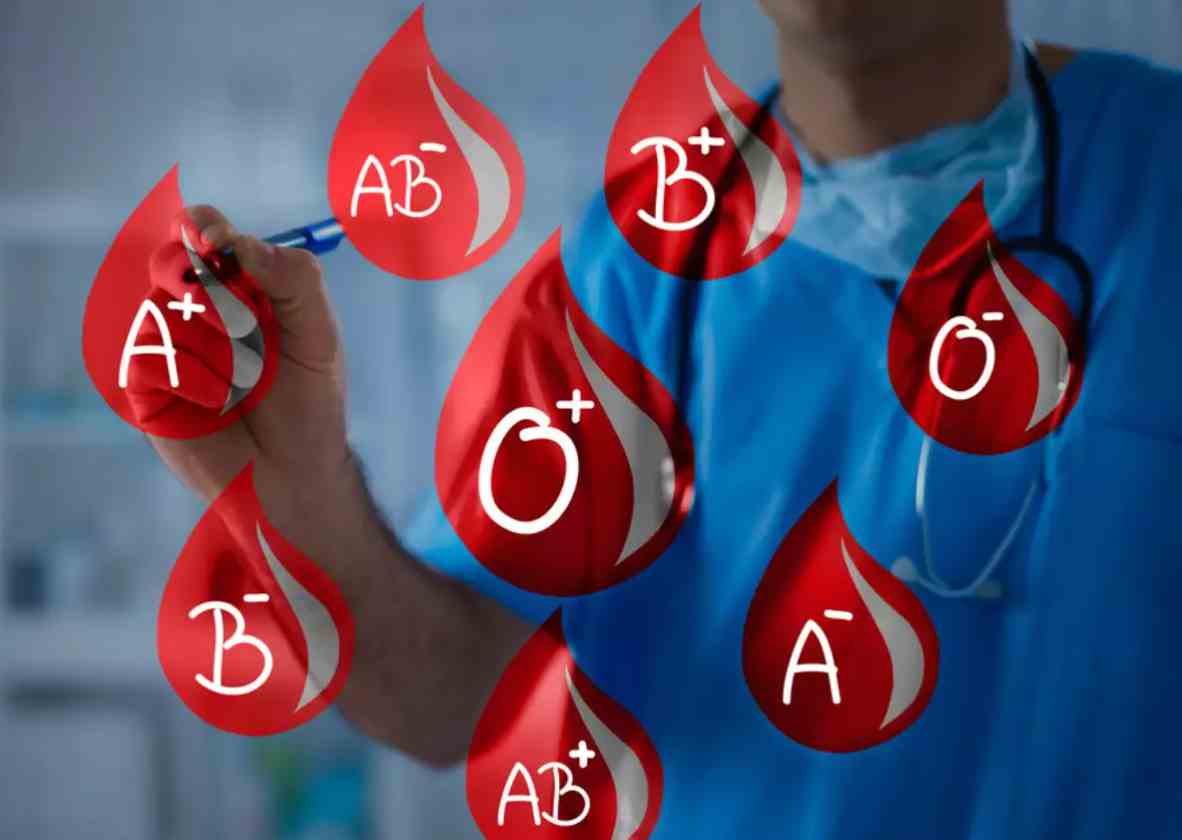
Introduction
- Everyone human has blood of similar color but not similar blood group/blood type. A blood type is a classification of blood, based on the presence and absence of antibodies and inherited antigenic substances on the surface of red blood cells. These antigens may be proteins, carbohydrates, glycoproteins, or glycolipids, depending on the blood group system. There are 8 types of blood groups mainly; A+, A-, B+, B-, AB+, AB-, O+, O-. Blood group O is the most common blood group and AB negative is the rarest of the eight main blood types.
History And Evolution
- In ancient days many people died due to a lack of blood transfusion and no idea about the blood groups. After the discovery of blood circulation by William Harvey in 1628, few scientists got the idea to transfer blood from one organism to another. Richard Lower transfused blood from one dog to another in 1665 and most of the dogs survived the transfusion. Later in 1667, Richard Lower and Jean-Baptiste Denis transfused blood from animals to humans and a huge number of people died this practice became illegal and for the next 150 years, no studies in blood transfusion were recorded. James Blundell in 1818 took blood for a patient’s husband and gave the patient suffering a post-partum hemorrhage, between 1825 and 1830 he performed ten of these transfusions, with five of the patients showing clinical benefits. In 1900 Karl Landsteiner discovered three human blood groups; A, B, and O blood groups. And was awarded the Nobel Prize for medicine in 1930. Then in 1902, Two students A. van Decastello and A. Sturli who worked with Karl Landsteiner discovered the fourth human blood group, the AB. These 4 blood groups are known as the ABO blood group system. Roger Lee in 1912, defined the terms ‘Universal donor’ and ‘Universal recipient’. He demonstrated that group O blood could be transfused in patients having any one of the four blood groups, while group AB patients could receive blood having any one of the four blood groups. Anticoagulants were introduced in 1914. In 1940, Karl Landsteiner and Alex Weiner discovered Another important blood group system Rh blood type. With all these discoveries, many people’s lives were saved. Blood groupings and blood transfusions play a vital role in human lives.
Types Of Blood Grouping Systems
- Mainly 2 types of blood grouping systems exist popularly. They include:
- ABO Blood grouping system
- Rh Blood groping system
- Other Blood grouping system
1. ABO Blood Grouping System:-
- The ABO group system is important during blood donation or blood transfusion. It contains many 4 types of blood groups based on the presence of antigens on red blood cell and antibodies in the plasma.
- Group A blood type contains antigen A on red blood cell and antibody B in the plasma.
- Group B blood type contains antigen B on red blood cell and antibody A in the plasma.
- Group AB blood type contains both A and B antigen on red blood cell and no antibodies (neither A nor B) in the plasma.
- Group O blood type contains neither A nor B antigen on red blood cell and both antibodies A and B in the plasma.
BLOOD GROUP | ANTIGEN | ANTIBODY |
A | Antigen A | Antibody B |
B | Antigen B | Antibody A |
AB | Antigen A&B | NO Antibody |
O | NO Antigen | Antibody A&B |
2. RH Blood Groping System:-
(Rhenus) Rh factor is an inherited protein found on the surface of red blood cells. Rh factor is also an antigen and its basically called antigen D. Based on its presence and absence it is positive and negative.
If the Rh factor is present on red blood cells it is Rh + blood group.
If the Rh factor is absent on red blood cells it is Rh – blood group.
Generally, the main 8 types of blood groups are described by combining the ABO Blood grouping system with the Rh Blood grouping system. They include:

A+ Blood group: containing antigen A, antibody B, Antigen D.
A- Blood group: containing antigen A, antigen B.
B+ Blood group: containing antigen B, antibody A, Antigen D.
B- Blood group: containing antigen B, antibody A.
AB+ Blood group: containing antigens A&B, No antibody, Antigen D.
AB- Blood group: containing antigen A&B, No antibody.
O+ Blood group: containing No antigen, antibody A&B, Antigen D.
O- Blood group: containing No antigen A, antibody A&B.
Bombay blood group: The rare, Bombay blood group was first discovered in Mumbai (then Bombay) in 1952 by Dr Y M Bhende. It is also called as Hh blood group as it lacks the H antigen on the RBC and have A, B, H antibodies in the plasma. As the H antigen is the precursor of the ABO blood group antigens, if it is not produced, the ABO blood group antigens are also not produced.
3. Other Blood Grouping Systems:-
- There are many other blood grouping systems that are unfamiliar like
- MNS
- P
- Lutheran
- Kelly
- Lewis
- Duffy
- Diego
- I
- Xg
- Y1
- Kidd groups.
- Scianna
- Dombrock
- Landsteiner-Wiener
- Gerbich
- Knops
- Raph
- Cromer
- RHGA
- Lan
- Junior
Blood Group Wise Distribution Of People Worldwide
BLOOD TYPE | PERCENTAGE OF PEOPLE WITH IT |
A+ | 35.7% |
A- | 6.3% |
B+ | 8.5% |
B- | 1.5% |
AB+ | 3.4% |
AB- | 0.6% |
O+ | 37.4% |
O- | 6.6% |
- The population of the A+ Blood group is 35.7%, the population of the A- Blood group is 6.3%, the population of the B+ Blood group is 8.5%, the population of the B- Blood group is 1.5%, The population of the AB+ Blood group is 3.4%, the population of AB- Blood group is 0.6%, The population of O+ Blood group is 37.45%, the population of O- Blood group is 6.6% worldwide.
Most Common Blood Group
- Out of the main 8 blood groups, O+ is the most common blood group worldwide.
Most Rare Blood Group
- Out the main 8 blood groups the AB- is the rarest blood group worldwide.
Detection Of Blood Grouping
- A blood group can be detected easily by using a simple blood grouping test.
1. Requirements:-
- glass plate with 3 deep circles
- toothpicks
- anti-A sera
- anti-B sera
- anti-D sera
- blood sample
2. Procedure:-
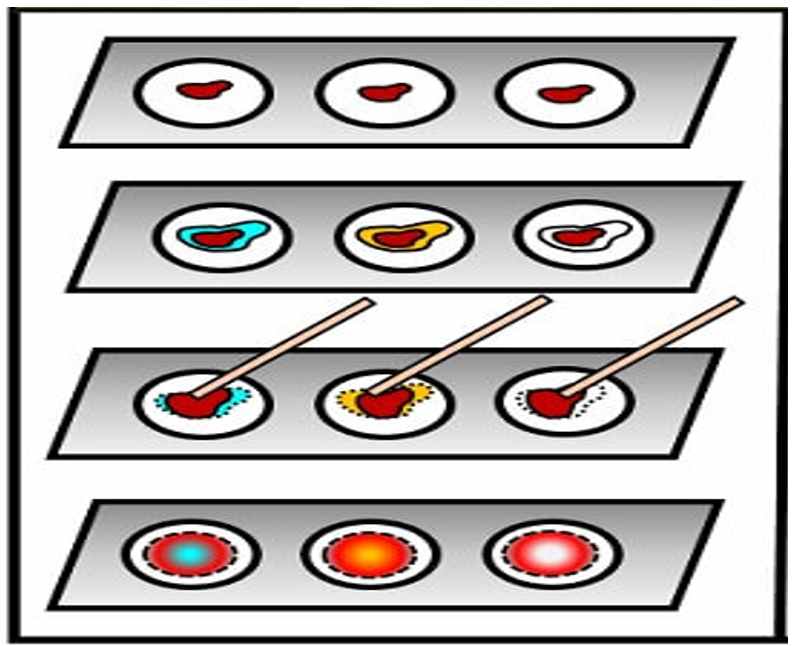
Add few drops of blood in each deep circle of the glass plate
⇓
Add antisera-A in the 1st circle, antisera-B in the 2nd circle and antisera-D in the 3rd circle
⇓
Mix the blood sample with the respective antisera properly using 3 tooth pics
⇓
Wait for at least 3 mins
⇓
By Finding the agglutination reactions formed in the circles we can detect the blood groups.
3. Identification:
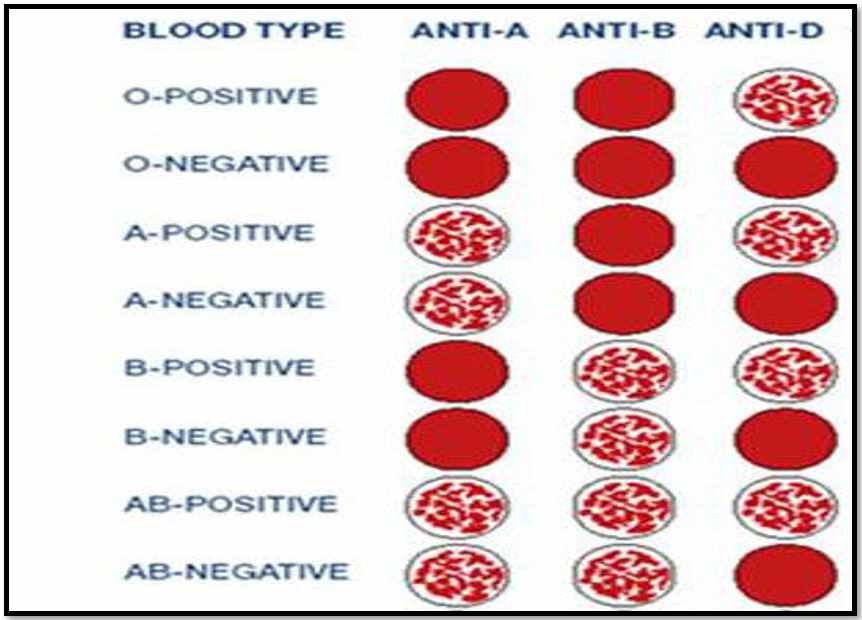
- “Agglutination is the clumping of particles that occurs if an antigen is mixed with its corresponding antibody called isoagglutinin.”
- O+ Blood group: If the agglutination reaction occurs in only the 3rd circle i.e., antisera-D and blood it is the O+ Blood group.
- O- Blood group: There will be no agglutination reaction in any of the circles.
- A+ Blood group: If the agglutination reaction occurs in 1st circle i.e., antisera-A and blood, and 3rd circle i.e., antisera-D and blood it is the A+ Blood group.
- A- group: If the agglutination reaction occurs in only in 1st circle i.e., antisera-A and blood it is A- Blood group.
- B+ Blood group: If the agglutination reaction occurs in 2ND circle i.e., antisera-B and blood, and 3rd circle i.e., antisera-D and blood it is the B+ Blood group.
- B- group: If the agglutination reaction occurs in only in 2nd circle i.e., antisera-B and blood it is B- Blood group.
- AB+ Blood group: If the agglutination reaction occurs all 3 circles; in 1st circle i.e., antisera-A and blood, in 2nd circle i.e., antisera-B and blood, and 3rd circle i.e., antisera-D and blood it is AB+ Blood group.
- AB- Blood group: If the agglutination reaction occurs in 1st circle i.e., antisera-A and blood, AND in 2nd circle i.e., antisera-B and blood it is AB- Blood group.
Significance Of Blood Grouping
There are mainly three significances. They include:
- Blood transfusion
- Identification of complications during pregnancy
- Identify risk of diseases associated with the blood group
1. Blood Transfusion:-
Blood transfusion is the process of transferring blood products into a person’s circulation intravenously. It is used to replace blood or blood components that are too low.
In case of the emergency situations like blood loss, accidents, severe anaemia, low platelets, surgery, the role of the blood transfusion is vital. So, you need a compatible blood group.
The blood needed for the transfusion will be collected from the donors and stored in the blood blank.
- There are four types of blood transfusions. They include:
- Whole blood transfusion; if they have experienced a severe traumatic haemorrhage and require red blood cells, white blood cells, and platelets.
- Plasma transfusion;if they have experienced severe burns, infections, or liver failure.
- Red blood cell transfusion; if they have low red blood cells, anaemia.
- Platelets transfusion; if they have low platelet count.
To get your blood transferred there should have a donor-lets see about blood donation;
“BLOOD DONOR is a person who gives blood for use in transfusion.”
“BLOOD RECEPIENT is a person who receives blood for use in transfusion.”
Criteria to donate blood:-
There are several parameters that determine the eligibility of an individual to donate blood. Guidelines laid down by the Ministry of Health, Government of India have to be followed by blood banks for donor screening.
Eligible:-
- Should not be suffering from transmittable diseases.
- Age should be between 18 and 65 years.
- Should weigh a minimum of 50 kg.
- Pulse rate should be Between 50 and 100.
- A minimum of 12.5 g/dL of Hb should be maintained.
- Blood pressure- Diastolic: 50–100 mm Hg, Systolic: 100–180 mm Hg.
- Body temperature should be normal
- The time period between successive blood donations should be more than 3 months.
Ineligible:-
- HIV positive.
- Suffering from ailments like cardiac arrest, hypertension, blood pressure, cancer, epilepsy, kidney ailments and diabetes, asthma with active symptoms, fits, tuberculosis or allergic disorders in the past.
- Pregnant or breastfeeding women.
- Consumed alcohol in the past 24 hours.
- Underwent immunizationin the past 1 month.
- Underwent major dental procedures or general surgeries in the past 1 month.
- Have had ear/body piercingor tattoo in the past 6 months.
- Treated for rabiesor received Hepatitis B vaccine in the past 6 months.
- Women who have had miscarriagein the past 6 months.
Procedure of blood donation:-
Donor will lie on the cot in the blood donation room.
⇓
A phlebotomist (an employee who draws blood) will clean your arm and insert a new, sterile needle into your vein.
⇓
Blood gets collected into the blood bag and you will donate 1 unit of blood.
⇓
It takes about 15mins for whole blood donation and more than 2hrs for red blood cell, platelets, plasma donation.
⇓
When you are done, they will remove the needle and paste a adhesive tape on that area.
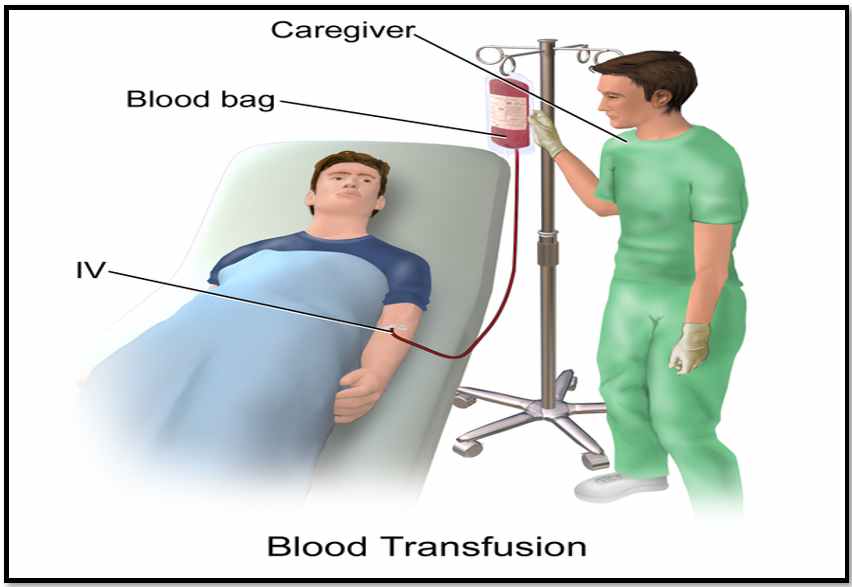
Blood Type Compatibility:-
BLOOD TYPE | YOU CAN GIVE | YOU CAN RECEIVE |
A+ | A+, AB+ | A+, A-, O+, O- |
A- | A+, A-, AB+, AB- | A-, O- |
B+ | B+, AB+ | B+, B-, O+, O- |
B- | B+, B-, AB+, AB- | B-, O- |
AB+ | AB+ | Everyone |
AB- | AB+, AB- | AB-, A-, B-, O- |
O+ | O+, A+, B+, AB+ | O+, O- |
O- | Everyone | O- |
A+ Blood group can donate blood to A+, AB+.
A+ Blood group can receive blood from A+, A-, O+, O-.
A- Blood group can donate blood to A+, A-, AB+, AB-.
A- Blood group can receive blood from A-, O-.
B+ Blood group can donate blood to B+, AB+.
B+ Blood group can receive blood from B+, B-, O+, O-.
B- Blood group can donate blood to B+, B-, AB+, AB-.
B- Blood group can receive blood from B-, O-.
AB+ Blood group can donate blood to AB+.
AB+ Blood group can receive blood from Everyone.
AB- Blood group can donate blood to AB+, AB-.
AB- Blood group can receive blood from AB-, A-, B-, O-.
O+ Blood group can donate blood to O+, A+, B+, AB+.
O+ Blood group can receive blood from O+, O-.
O- Blood group can donate blood to Everyone.
O- Blood group can receive blood from O-.
O negative blood type is known as the “Universal donors” as they can donate blood to any group.
AB-positive blood type is known as the “universal recipient” as they can receive blood from any group.
2. Identification Of Complications During Pregnancy:-
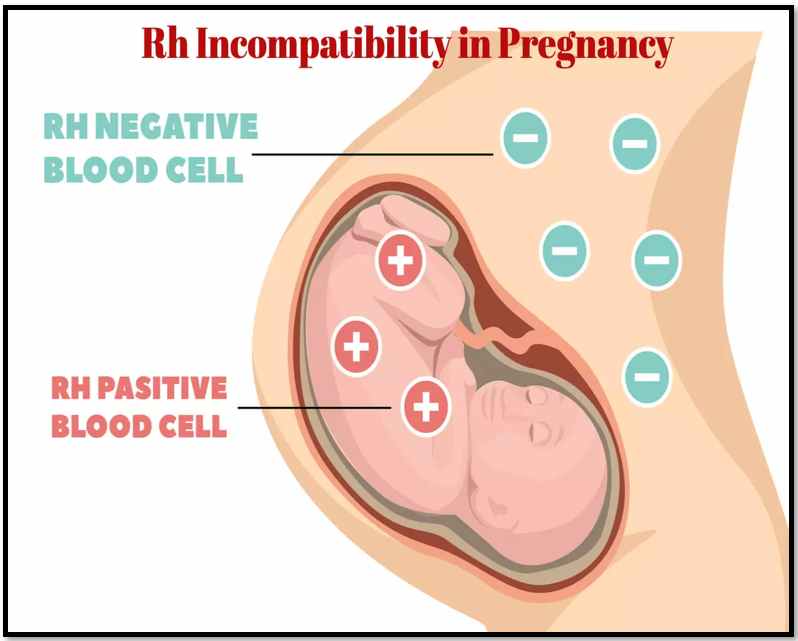
It’s a must and should to identify the blood groups of the mother and the foetus during pregnancy.
It’s possible to determine if an unborn baby is RhD-positive or RhD-negative by taking a simple blood test during pregnancy.
During pregnancy, problems can occur if you are Rh negative and your foetus is Rh positive and in its mildest form, Rh incompatibility causes the destruction of red blood cells in the foetus.
Treatment as soon as possible is very important to protect both the mother and baby.
So, the identification of blood groups plays a key role in the detection of complications during pregnancy.
3. Identify Risk Of Diseases Associated With The Blood Group:-
- According to few researches, higher risk to few diseases is associated with few diseases. Here are few examples:
- People with type O blood are less susceptible to malaria.
- People with type O blood are the least likely to suffer from cardiovascular issues.
- People with type A blood are more likely to develop stomach cancer.
- Non-O blood types are at an elevated risk of pancreatic cancer.
- AB blood are much more likely to develop cognitive issues.
- People with negative blood types tend to have more mental health issues and also have more skin allergies.
- Women with type O blood are more likely to deal with fertility issues.
- People with type B blood are more susceptible to gastroenteric cancers.
- Non-O blood types suffer from serious clotting issues more often than O types.
- Non-O blood types are at higher risk of type 2 diabetes.
Top 13 Intresting Facts About Blood Grouping
Karl Landsteiner is known as Father of blood grouping and immunochemistry.
People with type O have the lowest risk for heart disease.
According to few research studies, maximum hair growth occurs in O+ blood group and minimum hair growth occurs in B+ blood group.
Blood group O is the most common blood group and AB negative is the rarest of the eight main blood types.
Your pregnancy needs special care if you’re Rh negative and your baby is Rh positive.
37% of world’s population is filled with O+ blood group.
Golden blood is not actually golden in colour, but it is actually the nickname for Rhnull, the world’s rarest blood type.
1 blood donation can help save the lives of up to 3 people. If you began donating blood at age 18 and donated every 90 days until you reached 60, you would have donated 30 gallons of blood, potentially helping save more than 500 lives!
Only 350 mlof blood is taken at the time of donation.
Shabir Hussain Khanis India’s biggest blood donor and has generously donated 174 pints of blood to those in need since 1980 known as Blood Brother.
Every 2 seconds someone needs blood and more than 38,000 blood donations are needed every day in India.
As long as your diabetes is well-managed and under control, you can donate.
According to some reports, India needs 15 million units of blood each year but manages to collect only 11 million units, a deficit of 4 million units.
FAQs
Yes sure, A+ and O+ can have a baby. As the Rh factor in the both individuals are same there is no chance for complications in pregnancy regarding blood group.
It may be harmful if you marry the opposite Rh guy and plan to have a pregnancy, but it can be managed with proper treatment. But the woman is at risk when she has a negative Rh factor (example: O-) and her partner has a positive Rh factor (example: O +).
AB- is the hardest blood type to bet because it has only 1% of donors.
According to few studies and surveys conducted O+ are the kindest people.
As O- is the universal donor and does not contain any antibodies to anti-A, anti-B, anti-D it’s the safest and cleanest blood type.
Rh-null is the world’s rarest blood type, its almost unavailable less than 50 people around last 50 years have it and hence its known also known as most mysterious blood type.
Rh-null is the world’s rarest blood type, less than 50 people around last 50 years have it and hence its known as golden blood type.
Er blood group is the newest blood group and 44th blood group. According to a study there are now a total of five Er antigens in this group based on genetic variations and it can cause immune cells to attack mismatched cells where blood types are incompatible.
The population of AB- Blood group is 0.6% and is the first rarest blood group followed by the population of AB+ Blood group is 3.4% second rarest.
Platelets in A- blood are the most commonly needed by hospitals when treating patients with blood cancers. These platelets are crucial in helping blood to clot and donations can be given to patients with all other blood types. So, A-type is always in high demand.
It’s known as the Universal Donor blood type and the most special thing is any blood group people can receive blood from O- people. It’s also the healthiest blood type. O-negative donors are known as Heroes for Babies at the Red Cross because it is the safest blood for transfusions for immune-deficient newborns.







